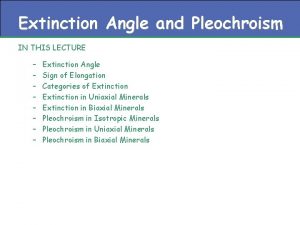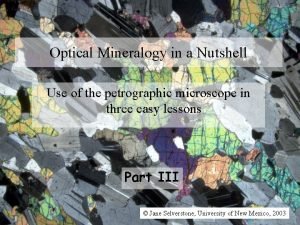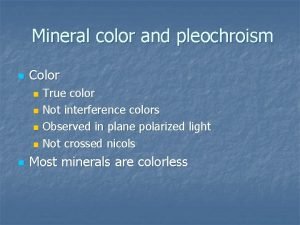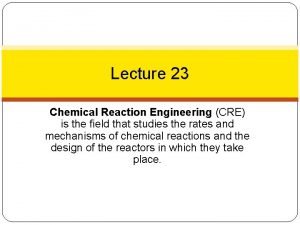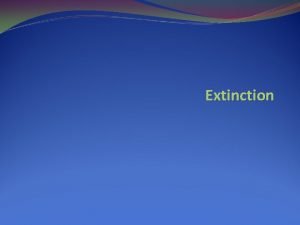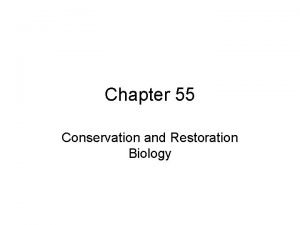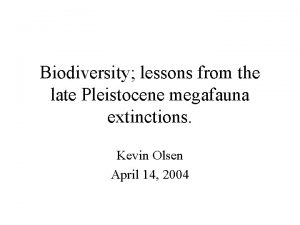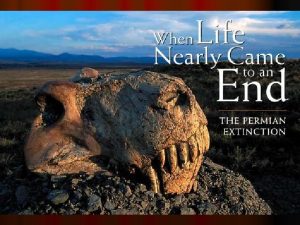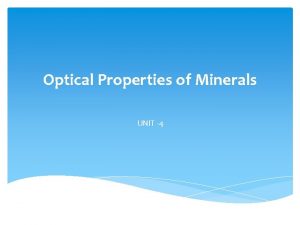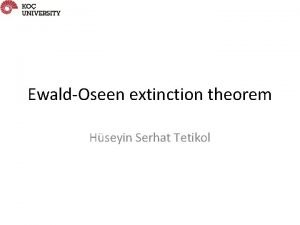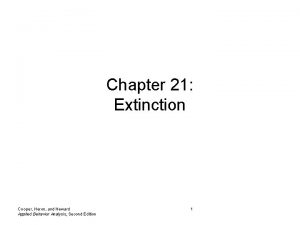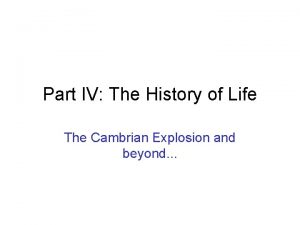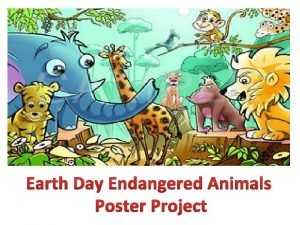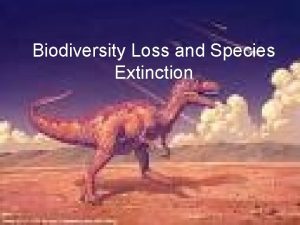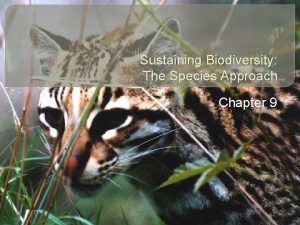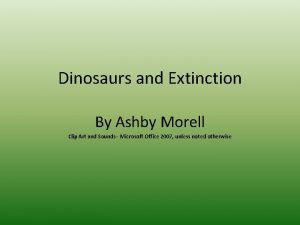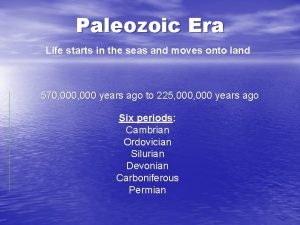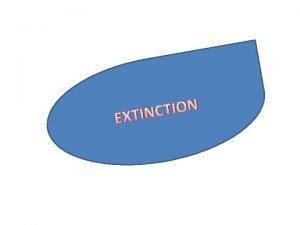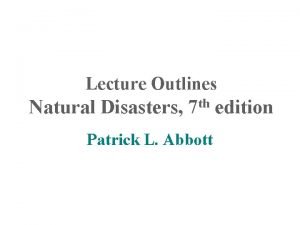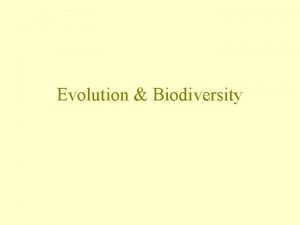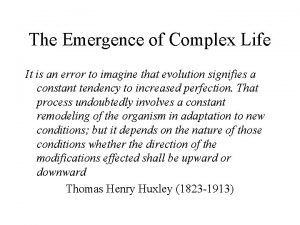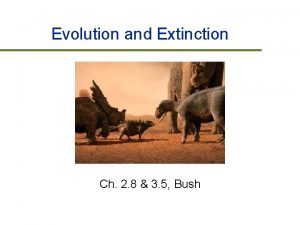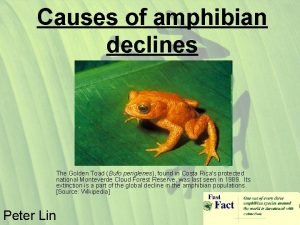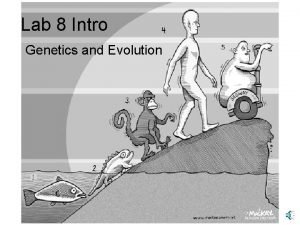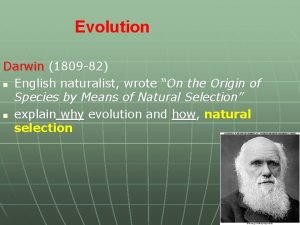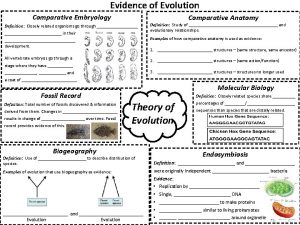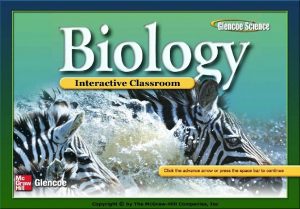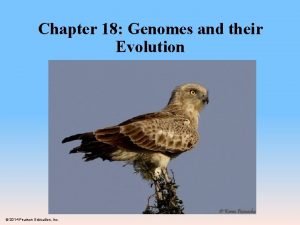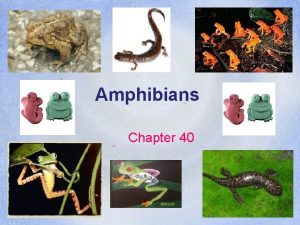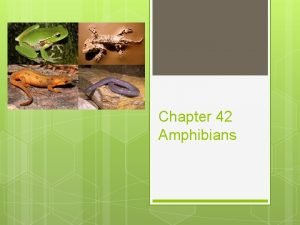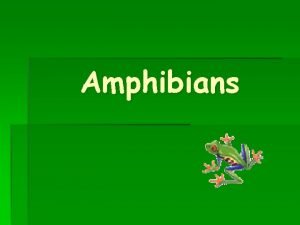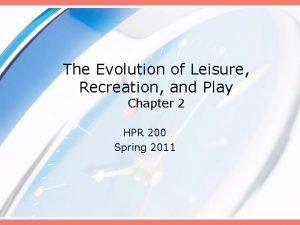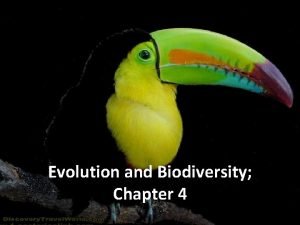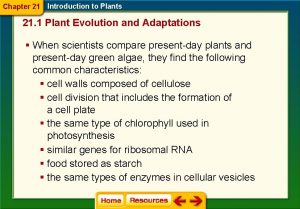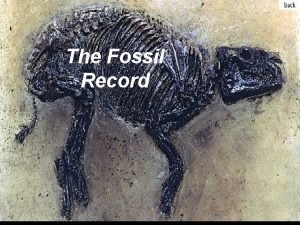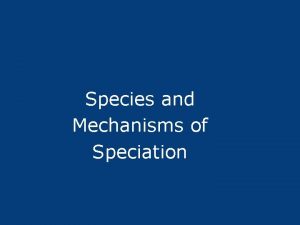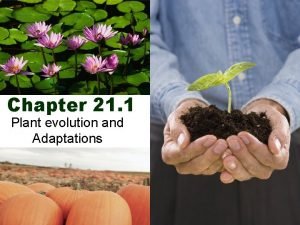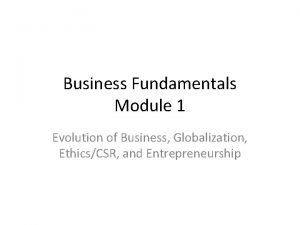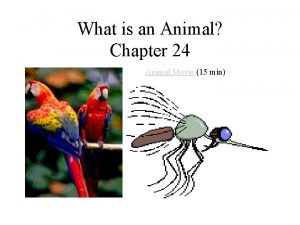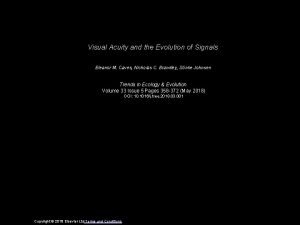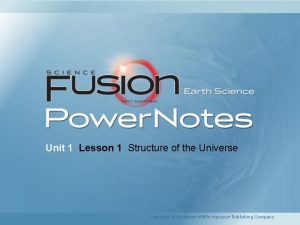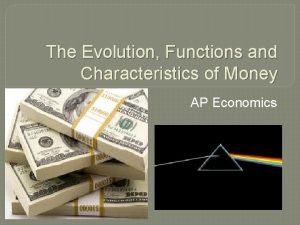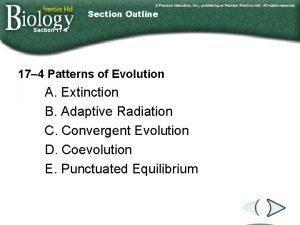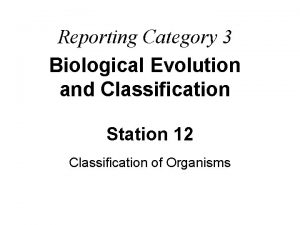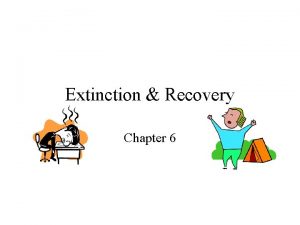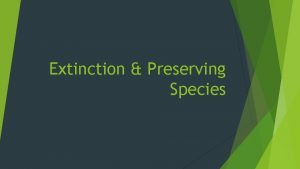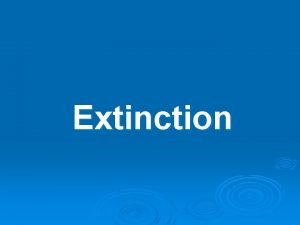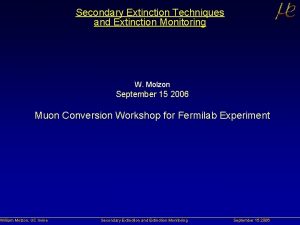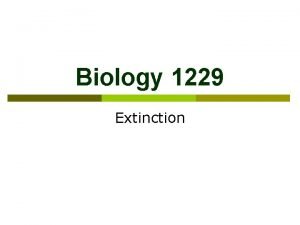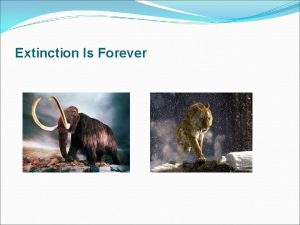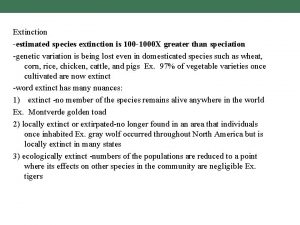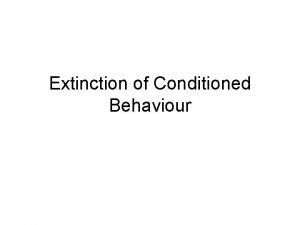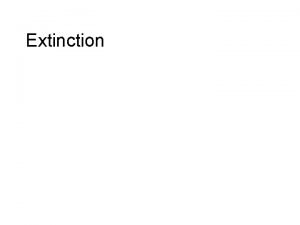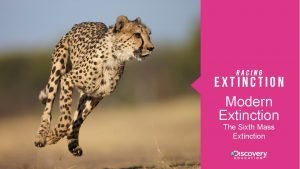Evolution and Extinction Ch 2 8 3 5








































































- Slides: 72

Evolution and Extinction Ch. 2. 8 & 3. 5, Bush

Evolution and Extinction v Extinction mechanisms v Human-induced v How Extinction many species can we lose?

Evolution and Extinction v Extinction mechanisms v Human-induced v How Extinction many species can we lose?

Extinction mechanisms v The signature of two very different extinction mechanisms appears evident in the fossil record: – Background extinction – Mass extinction

Cause of Background extinction v the result of biotic interactions (ecological and evolutionary), gradually changing climates and landscapes and, in the case of small populations, chance v Like the death of individuals, extinction is a natural part of life's ebb and flow

Population fluctuations

Extinction within a region v following a perturbation, rate at which species form increases, then levels off or even decreases as all of the ecological niches become filled v At the same time, extinction rates continue to rise as species are forced into ever more narrow ways of life v system reaches equilibrium number of species

Extinction within a region

Magnitude of Background Extinction v 99% of all species that have ever existed on the Earth are now gone v Scientists have found that the normal species extinction rate on a geological time scale is one species every 10, 000 years v Based on the fossil record, most species exist for 4 -22 million years

Main Mass Extinction Events 1. 2. 3. 4. many fish species became extinct near the beginning of the Devonian period (409 mya) 90% of marine species and several terrestrial organisms became extinct at the end of the Permian period (245 mya) end of Cretaceous era (65 mya), when dinosaurs went extinct Pleistocene (1. 8 mya) many grazing animals went extinct (as well as the sabretoothed cats, woolly mammoth)

Causes of Mass Extinctions v Climate: Changes in the climate always results in changes in the biota – e. g. , Pleistocene glaciation (1. 8 mya) resulted in significant extinction of grazing animals in North America and Eurasia, but not in Africa and portions of South America v Meteorite: Impact of large or numerous meteorites. – e. g. , End of Cretaceous probably caused by meteorite hitting the earth near Yucatan; iridium layer found at same level all around the earth

Climatic changes and mass extinction • glaciation causes: • severe decrease in temperature • sea levels drop

Meteorite-caused extinctions

Cretaceous extinction v Meteorite caused so much dust as to block out the sun, causing temperature drop and decrease in plant growth v Prevailing theory is that this caused the Cretaceous mass extinction

Mass Extinction creates opportunities v following a mass extinction there is a rapid increase in species as the survivors speciate to fill the vacated niches – E. g. , mammals were mostly small and nocturnal for 75 million years but diversified in to many larger and diurnal forms once the dinosaurs went extinct.

Extinction within a region

Evolution and Extinction v Extinction mechanisms v Human-induced v How Extinction many species can we lose?

Human-Induced Extinction v Examples v Causes v What of extinction organisms and which areas are most at risk?

Extinct passenger pigeon v In the early 1800 s, billions of passenger pigeons could be found in North America. Over the next century, the birds were killed in their millions by people. The last one died in a zoo in 1914

“Gone with the dodo” v v First seen by Europeans in 1507, the dodo was extinct by 1681 forest clearing destroyed the bird’s habitat, and introduced pigs, goats, cats, rats, and monkeys became competitors as well as predators

Recent Extinction v v Banff Longnose Dace was only found in Banff National Park, in a marsh into which the Cave and Basin Hot springs drain killed-off by the introduction of tropical fishes, leakage of chlorine from a swimming pool into the marsh, and construction of a beaver dam

Causes of extinction Habitat destruction v Overexploitation v – Hawaii : Arrival of Polynesians causes extinction of at least 39 species of endemic land birds v Introduction of pests, predators and competitors – Rats, house cats: decimated endemic pacific island birds which are mostly ground-nesting v Extinction has a domino effect – In Hawaii, many species of the Lobelia tree are endangered, due to the declining populations (extinction) of native nectar feeding birds

Magnitude of Human-induced mass extinction v normal species extinction rate on a geological time scale is one species every 10, 000 years v By 1950, however, the rate had increased to one species every 10 years. v Today, the rate is estimated at one or more species per day

Among the casualties. . v More than half the 266 species of exclusively freshwater fishes in peninsular Malaysia. v All of the 11 native tree-snail species of Moorea in the Society Islands. v More than 90 plant species growing on a single mountain ridge in Ecuador, through clear-cutting of forest between 1978 and 1986

What species are most at risk? v Most species are rare and fall into one of two categories: – limited specialists – widespread generalists

Generalists v found over a large geographic range but within that range they are usually rare or patchy in abundance v tolerant to a wide range of environmental conditions, flexible diet, weak symbiotic relationships v often do well in disturbed habitats

Generalist distribution Distribution of the blue damselfly

Specialists v have small, limited geographic range v specialized adaptations to one habitat and may have tight symbiotic relationship with another organism v usually better competitors than generalists in the environment they are adapted to v not as resilient to disturbance

Endemism endemic: a species found in a particular region, and nowhere else v levels of endemism high for areas that have been isolated for long periods of time, especially islands v Dodo bird: (was) endemic to Mauritius

Where is (will) the most species go(ing) extinct? 25 “Biodiversity Hotspots”

Ocean species are at risk too v Tropical coral reefs and the megafauna (e. g. , fish) that depend on them are seriously threatened v Sedimentation from upland deforestation, pollution, and overfishing are major threats to many reefs

Evolution and Extinction v Extinction mechanisms v Human-induced v How Extinction many species can we lose?

Hypotheses for the effect of extinction v "Rivet popper": – Each species is important in its own small way, lose one (like a rivet in a plane) and little happens but the ecosystem weakens. Lose several species and at some point the whole system fails. v "Redundancy": – Most species are superfluous as only a few are critical to the survival of the ecosystem. Species are like passengers on the plane, even with only a few, the plane can still fly

How many can go extinct? v the more complex the food web, the more likely we can withstand the extinction of any one member

Rivet popper vs. Redundancy Hypotheses v To know which of these hypotheses is correct, humans need to either: – let many species go extinct and see what happens (our present course of action) – learn a lot more about the ecology of biological systems

Example of a “Rivet Popper” system v Sea otters eat sea urchins which eat algae such as kelp

Sea Otter populations affects fish populations v. Sea otters disappeared from West Coast due to over-hunting by the fur industry vsea urchin populations exploded vkelp forests disappeared vkelp provided a home to many juvenile fish vecosystem sea otters was restored after re-introducing

Won’t new species evolve? v evolution required about 10 million years to restore the pre-disaster levels of diversity. v Evolution cannot perform as in previous ages if natural environments have been crowded out by artificial ones.

Summary v Extinction over Earth’s history has occurred through both background extinction and mass extinction events v Humans are presently imposing a mass extinction event on the rest of the Earth’s flora and fauna v How many extinction events the Earth can sustain before life as we know it is irreparably changed is unknown


Biodiversity Ch. 3, Bush

Biodiversity v Present v Patterns biodiversity knowledge in species richness v Maintaining biodiversity

Biodiversity v Present v Patterns biodiversity knowledge in species richness v Maintaining biodiversity

What is Biodiversity? v “Biological diversity is the wealth of life on earth, the millions of plants, animals, and microorganisms, the genes they contain, and the intricate ecosystems they help to build into the living environment. ” – WWF 1989

Levels of Biodiversity v Biodiversity exists at many levels of biological organization: – populations – species – communities – region

Biodiversity has increased over time

Six Kingdoms of Organisms

Current biodiversity knowledge Currently, about 1. 6 million species of plants and animals have been described by scientists v Approximately 900, 000 are insects, 41, 000 are vertebrates (mammals, birds, etc. ), and 250, 000 are plants. v The remaining species include various kinds of invertebrates, fungi, algae, and microorganisms v

How many species are there? v ~1. 6 million species have been described v this is only a small percentage of species; estimates of the actual number of species on Earth range from 4 -100 million! v large proportion of species are insects (~30 million insect species based on Erwin’s finding of 163 new species within a single tropical tree)

Many insects have yet to be described v E. g. , Hawaiian Drosophila pomace flies, only a few out of the estimated 1000 existing are described and named


Biodiversity v Present v Patterns biodiversity knowledge in species richness v Maintaining biodiversity

Patterns in biodiversity v Geographic v Ecological

Patterns in Species Richness v Latitudinal gradient – diversity decreases from equator to poles v Altitudinal Gradient – diversity decreases the higher you go up a mountain v Area gradient – diversity decreases as island size decreases

Species Richness of tree species

Species Richness of frog species

Tropical Biodiversity tropical rainforest v tropics cover approximately 6% of the earth's surface v contain more than half of all described species

Tropical Rainforest

Latitudinal Gradient Possible explanations include: 1. 2. 3. 4. history more habitat structure greater environmental stability high productivity of tropics

Tropical regions in the past

Habitat structure v e. g. , forest versus grassland different plant types (herbs, shrubs, trees) lead to patchy habitats which lead to higher species richness

Environmental stability – ice ages v repeated warming and cooling of temperate zones leads to increased extinction

Species richness and productivity

Productivity v more sunlight translates into more photosynthesis v no seasons so there is always flowers and fruit available v more to eat translates into more specialization

Patterns in biodiversity v Geographic v Ecological

Phylogeny and biodiversity Purple: species that have a certain trait Yellow: do not

Key Innovations and biodiversity

Biodiversity v Present v Patterns biodiversity knowledge in species richness v Maintaining biodiversity

Why is Biodiversity important? v insects, fungi, and other invertebrates provide many "services"-decomposition and nutrient recycling, population management of 'pest' species, pollination, etc. -that make the Earth a functioning system v Medicines v In the words of Aldo Leopold, "the first rule of intelligent tinkering is to save all the parts. "

Cures reside in biodiversity

Is there any room for optimism? “Yes!” says E. O. Wilson, leading expert in conservation: – Political movements vgreater support for biodiversity surveying – Pharmaceutical industry v"chemical prospecting" – Ecotourism vyields higher profits than logging or poaching

Summary v Biodiversity refers to the variation in species, populations, and genes v Biodiversity is increases with proximity to the tropics, decreases in altitude, increase in area, or habitat complexity v We need to maintain biodiversity in order for the ecosystems to continue to keep our water clean, keep producing products for us to use, reduce pest species etc.
 Emblem
Emblem Symmetrical extinction of minerals
Symmetrical extinction of minerals Optical activity
Optical activity Simultaneous extinction
Simultaneous extinction Extinction burst adalah
Extinction burst adalah True color of mineral
True color of mineral Ignition extinction curve
Ignition extinction curve Response blocking vs extinction
Response blocking vs extinction Extinction vortex
Extinction vortex Current background extinction rate
Current background extinction rate Simultaneous extinction
Simultaneous extinction Behaviorism ap psychology
Behaviorism ap psychology Permian extinction
Permian extinction Project termination by extinction
Project termination by extinction Basal section mineral
Basal section mineral Ewald-oseen extinction theorem
Ewald-oseen extinction theorem Extinction aba definition
Extinction aba definition Contoh extinction adalah
Contoh extinction adalah Permian extinction
Permian extinction Five conditions for hardy weinberg
Five conditions for hardy weinberg Stop poaching animals
Stop poaching animals Extirpation vs extinction
Extirpation vs extinction Partial reinforcement extinction effect
Partial reinforcement extinction effect Apes chapter 9 sustaining biodiversity
Apes chapter 9 sustaining biodiversity Extinction board
Extinction board Extinction clip art
Extinction clip art Mass extinction
Mass extinction Contoh kasus extinction
Contoh kasus extinction Quaternary extinction
Quaternary extinction Types of extinction
Types of extinction Alternatives to escape extinction
Alternatives to escape extinction Phaneozoic
Phaneozoic Modes of speciation ppt
Modes of speciation ppt Hyla
Hyla Evolution and interpretation of computer architecture
Evolution and interpretation of computer architecture Stabilizing selection human birth weight
Stabilizing selection human birth weight Similar
Similar History and evolution of repertory
History and evolution of repertory Graph evolution: densification and shrinking diameters
Graph evolution: densification and shrinking diameters Future of facilities management
Future of facilities management H
H Definition of comparative embryology
Definition of comparative embryology Evolution and community ecology guided notes
Evolution and community ecology guided notes Chapter 21 section 1 plant evolution and adaptations
Chapter 21 section 1 plant evolution and adaptations Computer evolution and performance
Computer evolution and performance Chapter 18 genomes and their evolution
Chapter 18 genomes and their evolution Evolution of populations section 16-1 genes and variation
Evolution of populations section 16-1 genes and variation Garde manger history
Garde manger history Kishore card repertory
Kishore card repertory Origin and evolution of amphibia
Origin and evolution of amphibia History of kent repertory
History of kent repertory Homeostasis evolution
Homeostasis evolution Future trends
Future trends Origin and evolution of amphibia
Origin and evolution of amphibia Origin and evolution of amphibia
Origin and evolution of amphibia Vocal sac opening frog
Vocal sac opening frog Evolution of leisure
Evolution of leisure Industry evolution and strategic change
Industry evolution and strategic change Chapter 5 evolution and community ecology
Chapter 5 evolution and community ecology Chapter 5 evolution and community ecology
Chapter 5 evolution and community ecology Chapter 4 biodiversity and evolution
Chapter 4 biodiversity and evolution Anthocerophytes
Anthocerophytes The evolution of crm is reporting analyzing and predicting
The evolution of crm is reporting analyzing and predicting Evidence of evolution of remnants and impressions *
Evidence of evolution of remnants and impressions * Sympatric speciation example
Sympatric speciation example Hepaticophytes
Hepaticophytes Evolution and fundamentals of business
Evolution and fundamentals of business Asymmetrical
Asymmetrical Visual acuity and the evolution of signals
Visual acuity and the evolution of signals Structure and evolution of the universe. lesson 1
Structure and evolution of the universe. lesson 1 Characteristics of money
Characteristics of money Lesson 17: patterns and processes of evolution
Lesson 17: patterns and processes of evolution Category 3 biological evolution and classification
Category 3 biological evolution and classification

